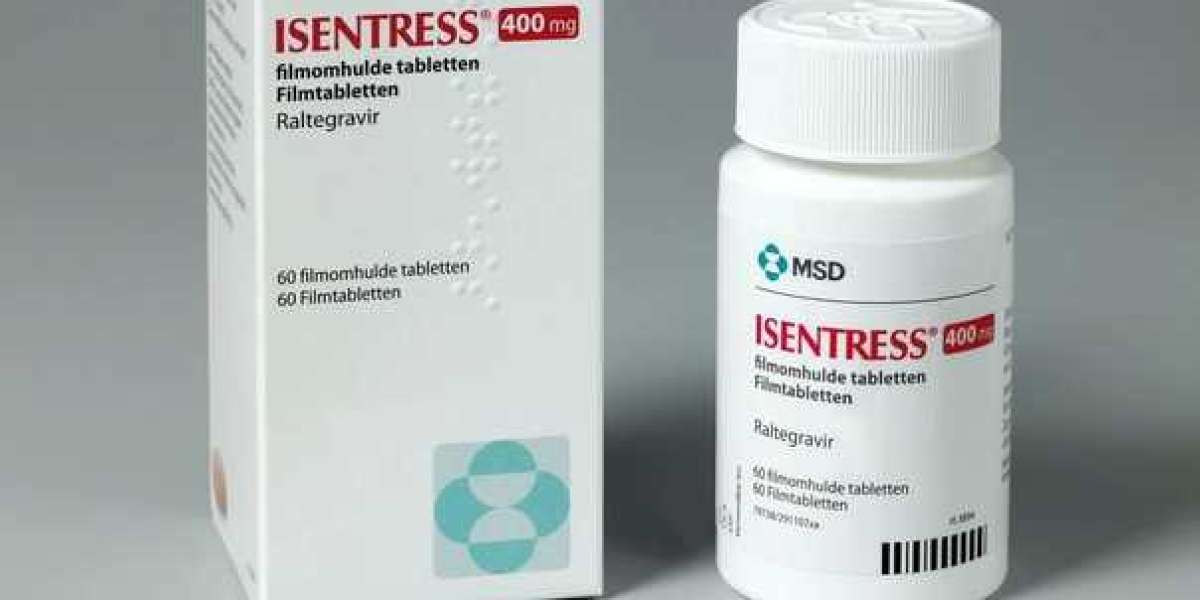HIV (Human Immunodeficiency Virus) remains a global health challenge, but advancements in antiretroviral therapy (ART) have transformed it into a manageable condition. One such treatment is Isentress 400 mg, a medication containing raltegravir, a pioneering integrase inhibitor. This blog dives into the science behind Isentress 400 mg, how it works to combat HIV, its role in treatment, and what patients need to know.
What is Isentress 400 mg?
Isentress 400 mg is a prescription medication used to treat HIV-1 infection in adults and children weighing at least 2 kg (4.4 lbs). Its active ingredient, raltegravir, belongs to a class of drugs called integrase strand transfer inhibitors (INSTIs). Approved by the FDA in 2007, Isentress is used in combination with other antiretroviral drugs to suppress HIV viral load and improve immune function. It is not a cure but helps control the virus, reducing the risk of HIV-related complications.
How Does HIV Work?
To understand Isentress, it’s essential to grasp how HIV operates. HIV is a retrovirus that attacks the immune system, specifically CD4 cells (T-cells), which are critical for fighting infections. The virus replicates through a multi-step life cycle:
Attachment and Entry: HIV binds to CD4 receptors on immune cells and enters them.
Reverse Transcription: Viral RNA is converted into DNA by the enzyme reverse transcriptase.
Integration: The viral DNA is inserted into the host cell’s DNA by the HIV integrase enzyme.
Replication: The host cell produces new viral proteins, assembling new HIV particles.
Release: New viruses are released to infect other cells.
If untreated, this cycle depletes CD4 cells, weakening the immune system and leading to AIDS (acquired immune deficiency syndrome).
The Science Behind Isentress 400 mg
Mechanism of Action
Isentress 400 mg targets the integration step of the HIV life cycle. Raltegravir inhibits the HIV integrase enzyme, which is responsible for inserting viral DNA into the host cell’s DNA. By blocking this enzyme, Isentress prevents HIV from integrating into the host genome, halting viral replication. This reduces the viral load (amount of HIV in the blood) and allows CD4 cell counts to recover, strengthening the immune system.
Why Integrase Inhibition Matters
Integration is a critical step unique to retroviruses like HIV. By targeting integrase, Isentress disrupts a process that other classes of antiretrovirals (e.g., protease inhibitors or reverse transcriptase inhibitors) do not address. This makes it a valuable component of combination ART, especially for patients with resistance to other drugs. Studies, such as the STARTMRK trial, showed that Isentress 400 mg twice daily, combined with other antiretrovirals, achieved undetectable viral loads in 87% of treatment-naive patients after 48 weeks, compared to 82% for efavirenz-based regimens.
Pharmacokinetics
Raltegravir is rapidly absorbed, with a median time to maximum concentration (Tmax) of about 1.5-2 hours in a fasted state. It is metabolized via glucuronidation in the liver, primarily by the UGT1A1 enzyme, and has a half-life of approximately 9 hours, necessitating twice-daily dosing for the 400 mg formulation. Unlike some antiretrovirals, it does not heavily rely on the cytochrome P450 system, reducing the risk of certain drug interactions.
How Isentress 400 mg Fits into HIV Treatment
Dosage and Administration
Adults: The typical dose is one 400 mg tablet taken orally twice daily, with or without food. For patients taking rifampin (a drug for tuberculosis), the dose increases to 800 mg twice daily due to rifampin’s effect on raltegravir metabolism.
Children: Dosing is weight-based for children weighing at least 2 kg, often using oral suspension or chewable tablets for younger patients. For those over 25 kg who can swallow tablets, 400 mg twice daily is standard.
Combination Therapy: Isentress is always used with other antiretrovirals, such as nucleoside reverse transcriptase inhibitors (e.g., tenofovir and emtricitabine), to target multiple stages of the HIV life cycle.
Who Can Benefit?
Isentress 400 mg is approved for:
Treatment-naive patients: Those newly diagnosed with HIV.
Treatment-experienced patients: Individuals with prior ART exposure, including those with drug-resistant HIV strains.
Pediatric patients: Children as young as newborns (if ≥2 kg), with adjusted dosing.
Pregnant women: Raltegravir is a preferred option for HIV treatment during pregnancy due to its safety profile and ability to cross the placenta, reducing mother-to-child transmission.
Efficacy
Clinical trials, like STARTMRK and REALMRK, demonstrate Isentress’s effectiveness. In treatment-naive patients, it achieves viral suppression (HIV RNA 50 copies/mL) in 86-89% of cases after 48 weeks, comparable to other first-line regimens. It also increases CD4 counts by approximately 230 cells/mm³ after one year, supporting immune recovery. Its efficacy is consistent across diverse populations, including women and people of color.
Benefits of Isentress 400 mg
Favorable Side Effect Profile: Compared to older drugs like efavirenz, Isentress has fewer side effects, such as dizziness or abnormal dreams (6% vs. 34% in STARTMRK). Common side effects (e.g., headache, diarrhea, nausea) are mild and temporary.
Low Drug Interactions: Its metabolism via glucuronidation minimizes interactions with drugs processed by the cytochrome P450 system, making it suitable for patients with complex medication regimens.
Versatility: Effective in both treatment-naive and treatment-experienced patients, including those with resistant HIV strains.
Pregnancy Safety: Studies show no significant fetal harm, with high placental transfer aiding prevention of mother-to-child transmission.
Limitations and Considerations
Twice-Daily Dosing: Unlike Isentress HD (1200 mg once daily), the 400 mg formulation requires twice-daily dosing, which may be less convenient than single-tablet regimens (STRs) like Biktarvy.
Resistance Risk: HIV can develop resistance to raltegravir via mutations (e.g., Q148H, N155H), though this is less common with newer INSTIs like dolutegravir. Regular viral load monitoring and adherence are critical.
Side Effects: Rare but serious side effects include severe rashes, hypersensitivity reactions, and muscle damage (elevated creatine kinase). Patients with a history of myopathy or rhabdomyolysis should use caution.
Not a Cure: Isentress controls HIV but does not eliminate it, requiring lifelong treatment and regular medical follow-ups.
Practical Tips for Patients
Adhere to Dosing: Take Isentress 400 mg exactly as prescribed to maintain viral suppression and prevent resistance. If a dose is missed, take it as soon as remembered unless it’s nearly time for the next dose. Do not double up.
Monitor Side Effects: Report unexplained muscle pain, rash, or signs of infection (e.g., fever, fatigue) to your doctor immediately, as these may indicate serious reactions or immune reconstitution syndrome.
Inform Your Doctor: Disclose all medications, including over-the-counter drugs and supplements, to avoid interactions. Avoid antacids containing aluminum or magnesium within 2 hours of Isentress, as they may reduce absorption.
Regular Testing: Routine blood tests to monitor viral load and CD4 counts are essential to ensure treatment effectiveness.
Lifestyle Support: Maintain a healthy diet, exercise, and avoid sharing personal items (e.g., needles, razors) to prevent HIV transmission. Use barrier methods during sexual activity for added protection.
The Bigger Picture
Isentress 400 mg has been a cornerstone of HIV treatment since its approval, offering a potent and well-tolerated option for diverse patient groups. While newer INSTIs and single-tablet regimens have gained popularity, Isentress remains a preferred choice in specific scenarios, such as pregnancy and post-exposure prophylaxis (PEP). Its ability to rapidly reduce viral load and boost CD4 counts has improved quality of life for many, though adherence and resistance monitoring remain key.
Conclusion
Isentress 400 mg (raltegravir) is a scientifically robust tool in the fight against HIV, targeting the critical integrase enzyme to halt viral replication. Its efficacy, safety, and versatility make it a vital part of combination ART, particularly for treatment-naive, treatment-experienced, and pregnant patients. By understanding its mechanism, benefits, and limitations, patients can work with their healthcare providers to optimize treatment and live healthier lives with HIV.


